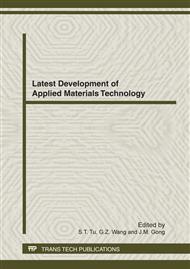[1]
E. F. Schubert, J. K. Kim, Solid-state light sources getting smart, Science 308 (2005) 1274-1278.
DOI: 10.1126/science.1108712
Google Scholar
[2]
W. J. Park, Y. H. Song, D. H. Yoon, Synthesis and luminescent characteristics of Ca2-xSrxSiO4: Eu2+ as a potential green-emitting phosphor for near UV-white LED applications, Mater. Sci. Eng. B 173 (2010) 76-79.
DOI: 10.1016/j.mseb.2010.01.041
Google Scholar
[3]
Y. Narukawa, S. Saijou, Y. Kawakami, S. Jujita, T. Mukai, S. Nakamura, Radiative and nonradiative recombination processes in ultraviolet light-emitting diode composed of an In0.02Ga0.98N active layer, Appl. Phys. Lett. 74 (1999) 558-560.
DOI: 10.1063/1.123144
Google Scholar
[4]
W. S. Song, Y. S. Kim, H. Yang, Yellow-emitting phosphor of Sr3B2O6: Eu2+ for application to white light-emitting diodes, Mater. Chem. Phys. 117 (2009) 500-503.
DOI: 10.1016/j.matchemphys.2009.06.042
Google Scholar
[5]
J. H. Lee, Y. J. Kim, Photoluminescent properties of Sr2SiO4:Eu2+ phosphors prepared by solid-state reaction method, Mater. Sci. Eng. B 146 (2008) 99-102.
DOI: 10.1016/j.mseb.2007.07.052
Google Scholar
[6]
M. Zhang, J. Wang, W. J. Ding, Q. H. Zhang, Q. Su, Luminescence properties of M2MgSi2O7: Eu2+ (M=Ca, Sr) phosphors and their effects on yellow and blue LEDs for solid-state lighting, Opt. Mater. 30 (2007) 571-578.
DOI: 10.1016/j.optmat.2007.01.008
Google Scholar
[7]
R. J. Xie, N. Hirosaki, K. Sakuma, Y. Yamamoto, M. Mitomo, Eu2+-doped Ca-α-SiAlON: A yellow phosphor for white light-emitting diodes, Appl. Phys. Lett. 84 (2004) 5404-5406.
DOI: 10.1063/1.1767596
Google Scholar
[8]
Y. X. Gu, Q. H. Zhang, Y. G. Ki, H. Z. Wang, R. J. Xie, Enhanced emission from CaSi2O2N2: Eu2+ phosphors by doping with Y3+ ions, Mater. Lett. 63 (2009) 1448-1450.
DOI: 10.1016/j.matlet.2009.03.045
Google Scholar
[9]
Y. Q. Li, G. D. With, H. T. Hintzen, Luminescence properties of Ce3+ activated alkaline earth silicon nitride M2Si5N8 (M=Ca, Sr, Ba) materials, J. Lumin. 116 (2006) 107-116.
DOI: 10.1016/j.jlumin.2005.03.014
Google Scholar
[10]
C. H. Hsu, R. Jagannathan, C. H. Lu, Luminescent enhancement with tunable emission in Sr2SiO4: Eu2+ phosphors for white LEDs, Mater. Sci. Eng. B 167 (2010) 137-141.
DOI: 10.1016/j.mseb.2010.01.045
Google Scholar
[11]
W. J. Park, M. K. Jung, S. M. Kang, T. Masaki, D. H. Yoon, Synthesis and photoluminescence characterization of Ca3Si2O7: Eu2+ as a potential green-emitting white LED phosphor, J. Phys. Chem. Solids 69 (2008) 1505-1508.
DOI: 10.1016/j.jpcs.2007.10.093
Google Scholar
[12]
Z. P. Yang, G. W. Yang, S. L. Wang, J. Tian, X. N. Li, Q. L. Guo, and G. S. Fu, A novel green-emitting phosphor NaCaPO4: Eu2+ for white LEDs, Mater. Lett. 62 (2008) 1884-1886.
DOI: 10.1016/j.matlet.2007.10.030
Google Scholar
[13]
S. H. Huang, L. R. Lou, Concentration dependence of sensitizer fluorescence intensity in energy transfer, Chin. J. Lumin. 11 (1990) 1-7.
Google Scholar
[14]
Q. Y. Meng, B. J. Chen, W. Xu, Y. M. Yang, X. X. Zhao, W. H. Di, S. Z. Lu, X. J. Wang, J. S. Sun, L. H. Cheng, T. Yu, Y. Peng, Size-dependent excitation spectra and energy transfer in Tb3+-doped Y2O3 nanocrystalline, J. Appl. Phys. 102 (2007) 093505 (6pp).
DOI: 10.1063/1.2803502
Google Scholar
[15]
Y. Tian, B. J. Chen, B. N. Tian, R. N. Hua, J. S. Sun, L. H. Cheng, H. Y. Zhong, X. P. Li, J. S. Zhang, Y. F. Zheng, T. T. Yu, L. B. Huang, Q. Y. Meng, Concentration-dependent luminescence and energy transfer of flower-like Y2(MoO4)3 :Dy3+ phosphor, J. Alloys. Compd. 509 (2011) 6096-6101.
DOI: 10.1016/j.jallcom.2011.03.034
Google Scholar
[16]
C. K. Jayasandar, V. Venkatramu, S. S. Babu, and P. Babu, Lumisecence properties of Dy3+ ions in a variety of borate and fluoroborate glasses containing lithium, zinc and lead, J. Alloys. Compd. 374 (2004) 22-26.
DOI: 10.1016/j.jallcom.2003.11.051
Google Scholar


